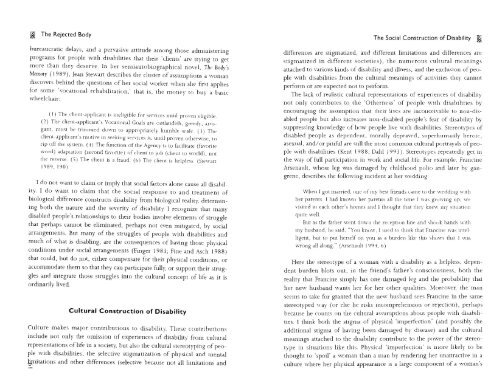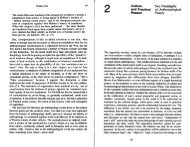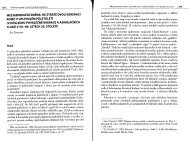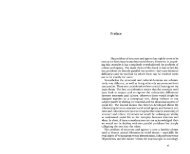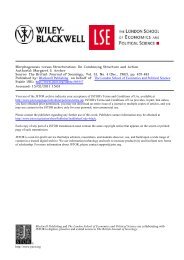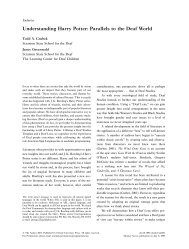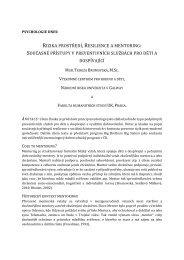~ <strong>The</strong> Rejected Body<strong>The</strong> <strong>Social</strong> <strong>Construction</strong> <strong>of</strong> <strong>Disability</strong> ~physical obstacles for people who use wheelchairs, hut also for people whoment, because it is <strong>of</strong>fered to citizens who fit the social paradigms, who bycan walk but cannot walk far or cannot climb stairs, for people who cannotdefinition are not considered dependent on social help. It is only whenopen doors, and felr people who can do all <strong>of</strong> these things but only at thepeople need a different kind or amount <strong>of</strong> help than that glVen to 'paradigm'citizens that it is cunsidered help at all, and they are consideredcost <strong>of</strong> pain or an expenditure <strong>of</strong> energy they can ill afTord. Some <strong>of</strong> thesame architectural flaws cause problems for pregnant women, parents withsocially dependent. Second, much, though not all, <strong>of</strong> the help that peoplestrollers, and young children. This is no coincidence. Much architecture haswith disabilities need is required because their bodies were damaged bybeen planned with a young adult, non-disabled male paradigm <strong>of</strong> humanityin mind. In addition, aspects <strong>of</strong> social orgamzation that take for grantedsocial conditions, or because they cannot meet social expectation, <strong>of</strong> performance,or because the narrowly-conceived physical structure and socialthe social expectatlOlls <strong>of</strong> performance and productivity, such as inadequateorganization <strong>of</strong> society have placed them at a disadvantage; in other words,public transportation (which I believe assumes that no one who is neededit is needed to overcome problems that were created socially.in the public world needs puhlic transportation), communications systemsThus disability is socially constructed through the failure or unwillingnessto create ability among people who do not fit the physical and mentalthat are inaccessible to people with visual or hearmg impairments, andinfleXible work arrangements that exclude part-time work or rest periods,pr<strong>of</strong>ile <strong>of</strong> 'paradigm' r.itizenx. Failures <strong>of</strong> social support tor people with disabilitiesresult in inadequate rehabilitation, unemployment, poverty,create much disabilityWhen public and private worlds are split, women (and children) haveinadequate personal and medical care, poor cornmunicauon services, inadequatetraining and education, poor protection from physical, sexual, and<strong>of</strong>ten been relegated to the private, and so have the disabled, the sick, andthe old. <strong>The</strong> public world is the world <strong>of</strong> strength, the positive (valued)emotional abuse, minimal opportunities for social learning and inreracuon,body, performance and production, the non-disabled, and young adultsand many other disabling situations that hurt people with disabilities andWeakness, illness, rest and recovery, pain. death, and the negame (devalued)exclude them from participation in major aspects <strong>of</strong> life in their societies.body are private, generally hidden, and <strong>of</strong>ten neglected. Coming into theFor example, Jong blued and Crichton (J 990, 35) point out that, inpublic world with illness, pain, or a devalued body, people encounter resistanceto mixing the two worlds; the split is vividly revealed. Much <strong>of</strong> theCanada and the United States, the helief that social assistance benefitsshould be less than can be earned in the work force, in order to provide anexperience <strong>of</strong> disability and illness goes underground, because there is noincentive for people to find and keep employment, has contributed tosocially acceptable way <strong>of</strong> expressing it and haVing the physical and psychologicalexperience acknowledged. Yet acknowledgement <strong>of</strong> this experience19SOs that they should receive disability pensions, these were set, as werepoverty among people with disabilities. Although it was recognized in theis exactly what is required for creating accessibility in the public world. <strong>The</strong>other forms <strong>of</strong> direct economic help, at socially minimal levels. Thus, evenmore a society regards disability as a private matter, and people with disabilitiesas belonging in the private sphere, the more disability it creates bygovernments as surplus labour since at least the 197 Os (because <strong>of</strong> persisthough unemployed people with disabilities have heen viewed by bothfailing to make the public sphere accessible to a wide range <strong>of</strong> people.tently high general rates <strong>of</strong> unemployment), and eHarts to increase their<strong>Disability</strong> is also socially constructed by the failure to give people theemployment opportunities have been minimal, they are kept at povenyamount and kind <strong>of</strong> help they need to participate fully in all major aspectslevel incomes' based on the 'incentive' principle Poverty is the single most<strong>of</strong> life in the society, including making a signiflcant contribution in thedisabling social circumstance for people with disabilities, since it meansform <strong>of</strong> work Two things are important to remember about the help thatthat they can barely afford the things that are necessities for non-disabledpeople with disabilities may need. One is that most industrialized societiespeople, much less the personal care, medicines, and technological aids theygive non-disabled people (in different degrees and kinds, depending onmay need to live decent lives outside institutions, or the training or educationor transportation or clothing that might enable them to work or toclass, race, gender, and other factors) a lot <strong>of</strong> help in the form <strong>of</strong> education,training, social support, public communication and trausportauor: facilities,participate more fully in public life.public recreation, and other services. <strong>The</strong> help that non-disabled peopleFailure or unwillingness to provide help <strong>of</strong>ten takes the form <strong>of</strong> irrationalrules governing insurance benefits and social assist ance.'s receive tends to be taken for granted and not considered help but entitle- long
~ <strong>The</strong> Rejected Bodyhureaucratic delays, and a pervasive attitude among those administeringprograms for people with disabilities that their 'clients' are trying to getmore than they deserve. In her semiautobiographical novel, <strong>The</strong> Body'sMemory (1989), Jean Stewart describes the cluster <strong>of</strong> assumptions a womandiscovers behind the questions <strong>of</strong> her social worker when she first appliesfor some 'vocational rehabilitation,' that is, the money to buy a basicwheelchair:(I) <strong>The</strong> clieur-applicant is ineligible for services until proven eligible(2) <strong>The</strong> client-applicant's Vocational Goals are outlandish, greedy, arrogam, must be trimmed duwn to appropriately humble scale. (3) TIll:'clicnt-applicanrs motive in seeking services is, until proven otherwise, torip <strong>of</strong>f the system. (+) <strong>The</strong> function <strong>of</strong> the Agency is to facilitate (favoriteword) adaptation (second favorite) <strong>of</strong> client to job (client to world) , notthe reverse. (S) <strong>The</strong> client is a fraud. (6) Tile client is helpless (Stewart1989,190)I do not want to claim or imply that social factors alone cause all disability.I do want to claim that the social response to and treatment <strong>of</strong>biological difference constructs disability from biological reality, determiningboth the nature and the severity <strong>of</strong> disability. I recognize that manydisabled people's relationships to their bodies involve elements <strong>of</strong> strugglethat perhaps cannot be eliminated, perhaps not even mitigated, by socialarrangements. But many <strong>of</strong> the struggles <strong>of</strong> people with disabilities andmuch <strong>of</strong> what is disabling, are the consequences <strong>of</strong> having those physicalconditions under social arrangements (Finger 1983; Fine and Asch 1988)that could, but do not, either compensate for their physical conditions, oraccommodate them so that they can participate fully, or support their strugglesand integrate those struggles into the cultural concept <strong>of</strong> life as it isordinarily lived.Cultural <strong>Construction</strong> <strong>of</strong> <strong>Disability</strong>Culture makes major contributions to disability. <strong>The</strong>se contributionsinclude not only the omission <strong>of</strong> experiences <strong>of</strong> disability from culturalrepresentations <strong>of</strong> life in a society, but also the cultural stereotyping <strong>of</strong> peo~ple with disabilities, the selective stigmatization <strong>of</strong> physical and mental!,iplitations and other differences (selecrive because not all limitations and,J<strong>The</strong> <strong>Social</strong> <strong>Construction</strong> <strong>of</strong> <strong>Disability</strong> ~differences are stigmatized, and different limitations and differences arestigmatized in different societies), the numerous cultural meaningsattached to various kinds <strong>of</strong> disability and illness, and the exclusion <strong>of</strong> peoplewith disabilities from the cultural meanings <strong>of</strong> activities they cannotperform or are expected not to perform.<strong>The</strong> lack <strong>of</strong> realistic cultural representations <strong>of</strong> experiences <strong>of</strong> disabilitynot only contributes to the 'Otherness' <strong>of</strong> people with disabilities byencouraging the assumption that their lives are inconceivable to non-disabledpeople but also increases non-disabled people's fear <strong>of</strong> disability bysuppressi.ng knowledge <strong>of</strong> how people live with disahilities. Stereotypes <strong>of</strong>disabled people as dependent, morally depraved, superhumanly heroic,asexual, and/or pitiful are still the most common cultural portrayals <strong>of</strong> peoplewith disabilities (Kent 1988; Dahl 1993). Stereotypes repeatedly get inthe way <strong>of</strong> full participation in work and social life. For example, FrancineArsenault, whose leg was damaged by childhood polio and later by gangrene,describes the follOWing incident at her wedding:When I got married, one <strong>of</strong> my hest friends came to the wedding withher parents. I had known her parents all the time I was gruwing up: wevisited in each other's homes and I thought that they knew Ill)' situationquite well.But as the father went down the recepnon line and


